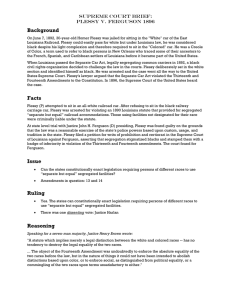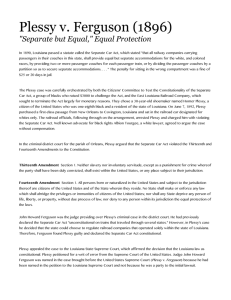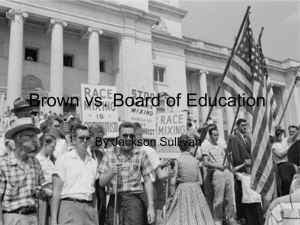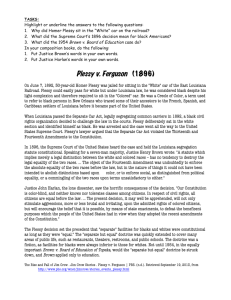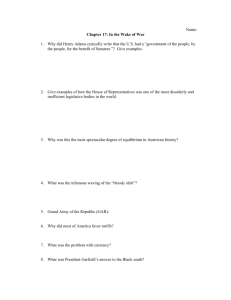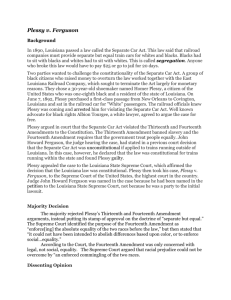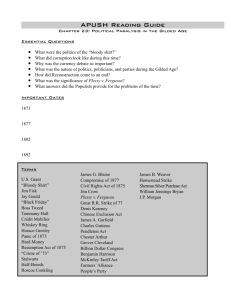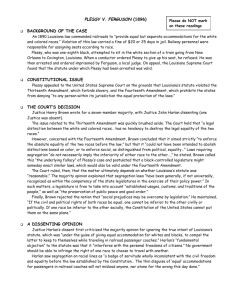social environment
advertisement
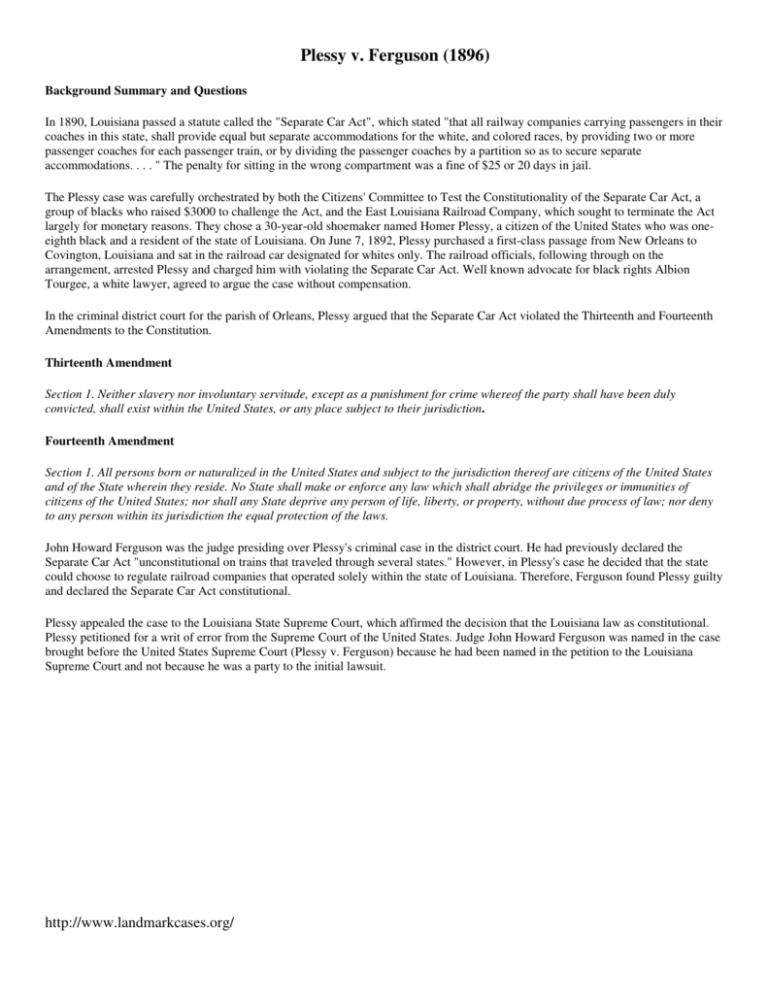
Plessy v. Ferguson (1896) Background Summary and Questions In 1890, Louisiana passed a statute called the "Separate Car Act", which stated "that all railway companies carrying passengers in their coaches in this state, shall provide equal but separate accommodations for the white, and colored races, by providing two or more passenger coaches for each passenger train, or by dividing the passenger coaches by a partition so as to secure separate accommodations. . . . " The penalty for sitting in the wrong compartment was a fine of $25 or 20 days in jail. The Plessy case was carefully orchestrated by both the Citizens' Committee to Test the Constitutionality of the Separate Car Act, a group of blacks who raised $3000 to challenge the Act, and the East Louisiana Railroad Company, which sought to terminate the Act largely for monetary reasons. They chose a 30-year-old shoemaker named Homer Plessy, a citizen of the United States who was oneeighth black and a resident of the state of Louisiana. On June 7, 1892, Plessy purchased a first-class passage from New Orleans to Covington, Louisiana and sat in the railroad car designated for whites only. The railroad officials, following through on the arrangement, arrested Plessy and charged him with violating the Separate Car Act. Well known advocate for black rights Albion Tourgee, a white lawyer, agreed to argue the case without compensation. In the criminal district court for the parish of Orleans, Plessy argued that the Separate Car Act violated the Thirteenth and Fourteenth Amendments to the Constitution. Thirteenth Amendment Section 1. Neither slavery nor involuntary servitude, except as a punishment for crime whereof the party shall have been duly convicted, shall exist within the United States, or any place subject to their jurisdiction. Fourteenth Amendment Section 1. All persons born or naturalized in the United States and subject to the jurisdiction thereof are citizens of the United States and of the State wherein they reside. No State shall make or enforce any law which shall abridge the privileges or immunities of citizens of the United States; nor shall any State deprive any person of life, liberty, or property, without due process of law; nor deny to any person within its jurisdiction the equal protection of the laws. John Howard Ferguson was the judge presiding over Plessy's criminal case in the district court. He had previously declared the Separate Car Act "unconstitutional on trains that traveled through several states." However, in Plessy's case he decided that the state could choose to regulate railroad companies that operated solely within the state of Louisiana. Therefore, Ferguson found Plessy guilty and declared the Separate Car Act constitutional. Plessy appealed the case to the Louisiana State Supreme Court, which affirmed the decision that the Louisiana law as constitutional. Plessy petitioned for a writ of error from the Supreme Court of the United States. Judge John Howard Ferguson was named in the case brought before the United States Supreme Court (Plessy v. Ferguson) because he had been named in the petition to the Louisiana Supreme Court and not because he was a party to the initial lawsuit. http://www.landmarkcases.org/ Plessy v. Ferguson (1896) 1. What law did Homer Plessy violate? How did Plessy violate this law? 2. What rights do the Thirteenth and Fourteenth Amendments to the Constitution provide? 3. If you were Plessy's lawyer, how would you justify your claim that the "Separate Car Act" violates the Thirteenth and Fourteenth amendments? 4. In State of Louisiana v. Plessy, Judge Ferguson decided that the state could choose to regulate railroad companies that operated within the state even though he had previously declared the "Separate Car Act" unconstitutional on trains that traveled through several states. If an act is declared unconstitutional in one case, shouldn't it be held unconstitutional in all cases? How do you think Judge Ferguson could legally justify making this distinction? 5. Is it possible for two races to remain separated while striving for equality? Are separation and equality compatible? Why or why not? 6. Can you think of an example or situation where separation does not mean inequality? 7. http://www.landmarkcases.org/ Brown v. Board of Education (1954) Background Summary and Questions In the early 1950s, Linda Brown was a young African American student in the Topeka, Kansas school district. Every day she and her sister, Terry Lynn, had to walk through the Rock Island Railroad Switchyard to get to the bus stop for the ride to the all-black Monroe School. Linda Brown tried to gain admission to the Sumner School, which was closer to her house, but her application was denied by the Board of Education of Topeka because of her race. The Sumner School was for white children only. Under the laws of the time, many public facilities were segregated by race. The precedent-setting Plessy v. Ferguson case, which was decided by the Supreme Court of the United States in 1896, allowed for such segregation. In that case, a black man, Homer Plessy, challenged a Louisiana law that required railroad companies to provide equal, but separate, accommodations for the white and African American races. He claimed that the Louisiana law violated the Fourteenth Amendment, which demands that states provide "equal protection of the laws." However, the Supreme Court of the United States held that as long as segregated facilities were qualitatively equal, segregation did not violate the Fourteenth Amendment. In doing so, the Court classified segregation as a matter of social equality, out of the control of the justice system concerned with maintaining legal equality. The Court stated, "If one race be inferior to the other socially, the constitution of the United States cannot put them on the same plane." At the time of the Brown case, a Kansas statute permitted, but did not require, cities of more than 15,000 people to maintain separate school facilities for black and white students. On that basis, the Board of Education of Topeka elected to establish segregated elementary schools. Other public schools in the community were operated on a nonsegregated, or unitary, basis. The Browns felt that the decision of the Board violated the Constitution. They sued the Board of Education of Topeka, alleging that the segregated school system deprived Linda Brown of the equal protection of the laws required under the Fourteenth Amendment. No State shall . . . deny to any person within its jurisdiction the equal protection of the laws. —Equal Protection Clause of the Fourteenth Amendment of the U.S. Constitution Thurgood Marshall, an attorney for the National Association for the Advancement of Colored People (NAACP), argued the Brown's case. Marshall would later become a Supreme Court justice. The three-judge federal district court found that segregation in public education had a detrimental effect upon black children, but the court denied that there was any violation of Brown's rights because of the "separate but equal" doctrine established in the Supreme Court's 1896 Plessy decision. The court found that the schools were substantially equal with respect to buildings, transportation, curricula, and educational qualifications of teachers. The Browns appealed their case to the Supreme Court of the United States, claiming that the segregated schools were not equal and could never be made equal. The Court combined the case with several similar cases from South Carolina, Virginia, and Delaware. The ruling in the Brown v. Board of Education case came in 1954. http://www.landmarkcases.org/ Brown v. Board of Education (1954) 1. What right does the Fourteenth Amendment give citizens? 2. What problems did Linda Brown encounter in Topeka that eventually resulted in this case? 3. What precedent did the Plessy v. Ferguson (1896) ruling establish? How was that precedent related to Brown? 4. This case is based on what the concept of "equality" means. What are the conflicting points of view on this concept in this case? http://www.landmarkcases.org/ If You Were a Supreme Court Justice . . . The Brown v. Board of Education decision did not dictate how schools should desegregate. Many systems did not want to desegregate and experimented with ways to get around the Court decision in Brown to take advantage of the vague mandate. Many law suits were filed by minority students, the NAACP, and the Justice Department to force school districts to comply with the Brown decision. The law, however, was not always clear. As groups or as individuals, read the following descriptions of school segregation cases that came before the Supreme Court of the United States after the Brown v. Board of Education decision. Taking into consideration what you know about the Brown case and the spirit in which it was written, how would you decide each one? After you discuss each case, read how the actual Supreme Court of the United States decided the case. Swann v. Charlotte-Mecklenberg Board of Education (1971) The school district in question was a part-urban, part-rural district covering 550 square miles and serving 84,000 pupils in 101 schools. The school population was 29 percent black and those pupils were concentrated in one quadrant of Charlotte. Even after the Brown v. Board of Education decision, more than half of the black students attended schools without any white students or teachers. After the Green decision, the federal district court adopted a plan to scatter the highly concentrated black-student population by transporting students. The plan would involve 13,000 students and require 100 new buses at a cost of millions of dollars. If you were a Supreme Court justice, would you order the desegregation of this school district through a busing system to disperse students? http://www.landmarkcases.org/ Swann v. Charlotte-Mecklenberg Board of Education (1971) This decision struck down "racially neutral" student assignment plans that produced segregation by relying on existing residential patterns in the South. The Court in Swann ruled that desegregation must be achieved in each of a district's schools to the greatest possible extent and approved busing as a means to do so. http://www.landmarkcases.org/brown/summaries.html#swann http://www.landmarkcases.org/

